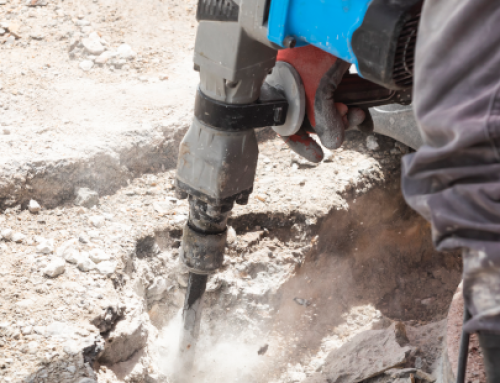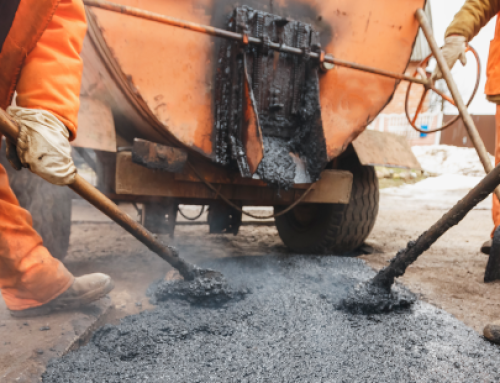We park on asphalt parking lots and drive on asphalt highways and roads every day, but how often do we think about the asphalt paving equipment required to build them?
Let’s take a look at the equipment needed to construct these asphalt surfaces and how it’s used.
Milling Machines
Milling machines are used to remove the top layer of an existing pavement before a new asphalt layer is laid. Milling can remove only the surface or the entire depth of the pavement, known as full-depth removal. Paved areas may need to be milled to level the surface or repair the damaged layer.
A milling machine, also called a cold planer, is a heavy-duty piece of equipment with a large rotating drum. Cutters inside the drum rotate and cut up the existing asphalt surface to the required depth. A vacuum sucks up the milled material where it’s loaded onto a conveyer belt attached to the milling machine. Water is typically applied to the drum during the milling process to reduce the machine’s extreme heat and minimize the dust milling causes. A dump truck moves alongside the milling machine to collect the material as it’s removed. This method saves both time and effort. The milled asphalt is recycled and used in other projects.
Sweepers
After the asphalt pavement has been milled, a sweeper is used to clean the surface. Large particles of debris can cause uneven compaction of the asphalt. Even small amounts of dust and debris left on the ground can prevent the new asphalt from bonding properly with the surface below. It’s also necessary to sweep after milling to prevent small rocks from hitting the oncoming traffic and damaging vehicles’ windshields.
Dump Trucks
Most asphalt paving job sites use several types of dump trucks to haul asphalt from the plant to the job site. Here are some of the most common ones:
- Bottom Dump – Bottom dump trucks are also known as belly dump trucks because they release their load from underneath instead of spilling it out like standard dump trucks. Sloped internal walls guide the asphalt out through opened gates.
- End Dump – These trucks raise the front end and let the asphalt slide down the bottom of the bed and out the back through a tailgate. End dump trucks are popular because they are versatile and easy to maneuver.
- Live Bottom – Live bottom, or flo-boy, dump trucks have a conveyor system at the bottom of their bed to unload their payload. Hot Mix Asphalt (HMA) is discharged out of the trucks’ bed without raising the bed. These trucks are more expensive to operate and maintain because of the conveyor system, but they can decrease segregation problems because the HMA is moved out in large piles. They can also eliminate some potential types of truck bed paver contact because the bed isn’t raised during the unloading process.
Asphalt Pavers
The asphalt paver is a self-propelled formless laydown machine with a floating screed. Hot Mix Asphalt is loaded in the front of the machine, transferred to the back by a set of flight feeders, spread out by a set of augers, then leveled and compacted by a screed. The asphalt paver has two main systems:
- Tractor – The tractor contains the material feed system, which takes in the HMA at the paver’s front, moves it to the back, and spreads it out to the necessary width.
- Screed – The self-leveling screed unit is the paver’s most significant feature because it flattens and compacts the asphalt after it’s poured on the surface.
Roller-Compactor
Three essential pieces of equipment are used for HMA compaction – the paver screed, the steel-wheeled roller, and the pneumatic tire roller. Each piece of equipment works to compress and compact the HMA to the underlying surface.
Depending on the job, other equipment may also be needed during an asphalt paving project. However, the machines listed above are the essential pieces of equipment used to pave parking lots, highways, and roads.
If you’d like to know more about the equipment we use or the paving process, we’d love to talk to you! Contact us today for a free estimate for your next residential or commercial project.








